Dr. Serhan Derin, born in 1982, is a seasoned ENT specialist who graduated from Ankara University School of Medicine. He completed his residency at Kocaeli University in 2010. Dr. Derin is a highly skilled surgeon specializing in functional and cosmetic nose surgeries, including Primary Rhinoplasty, Revision Rhinoplasty, Ethnic Rhinoplasty, Septoplasty, Septorhinoplasty, Nasal Valve Surgery, and Sinus Surgery.
Are you unhappy with the appearance of your nose or have trouble breathing through your nostrils? If so, you may be considering rhinoplasty and you should have a lot of questions in your mind about this intricate procedure. First things first, you need to know the basics of this surgery: What is rhinoplasty?
Rhinoplasty is a surgery to improve your nose either cosmetically or functionally. During the procedure, surgeons carefully manipulate the inner and outer nose structures to create an aesthetically pleasing appearance, enhance the breathing experience, or both.
Some achievements of surgery might include reconstructive correction of a birth deformity and opening the nasal passages or purely cosmetical dorsal hump reduction and tip refinements.
What are the risks and benefits, and who makes an ideal candidate for the procedure? And what should you expect during the recovery process? In this article, you will find comprehensive answers to these questions, and explore the diverse methodologies surgeons employ to alter the shape of the nose.
Let’s start: what do you really know about rhinoplasty?
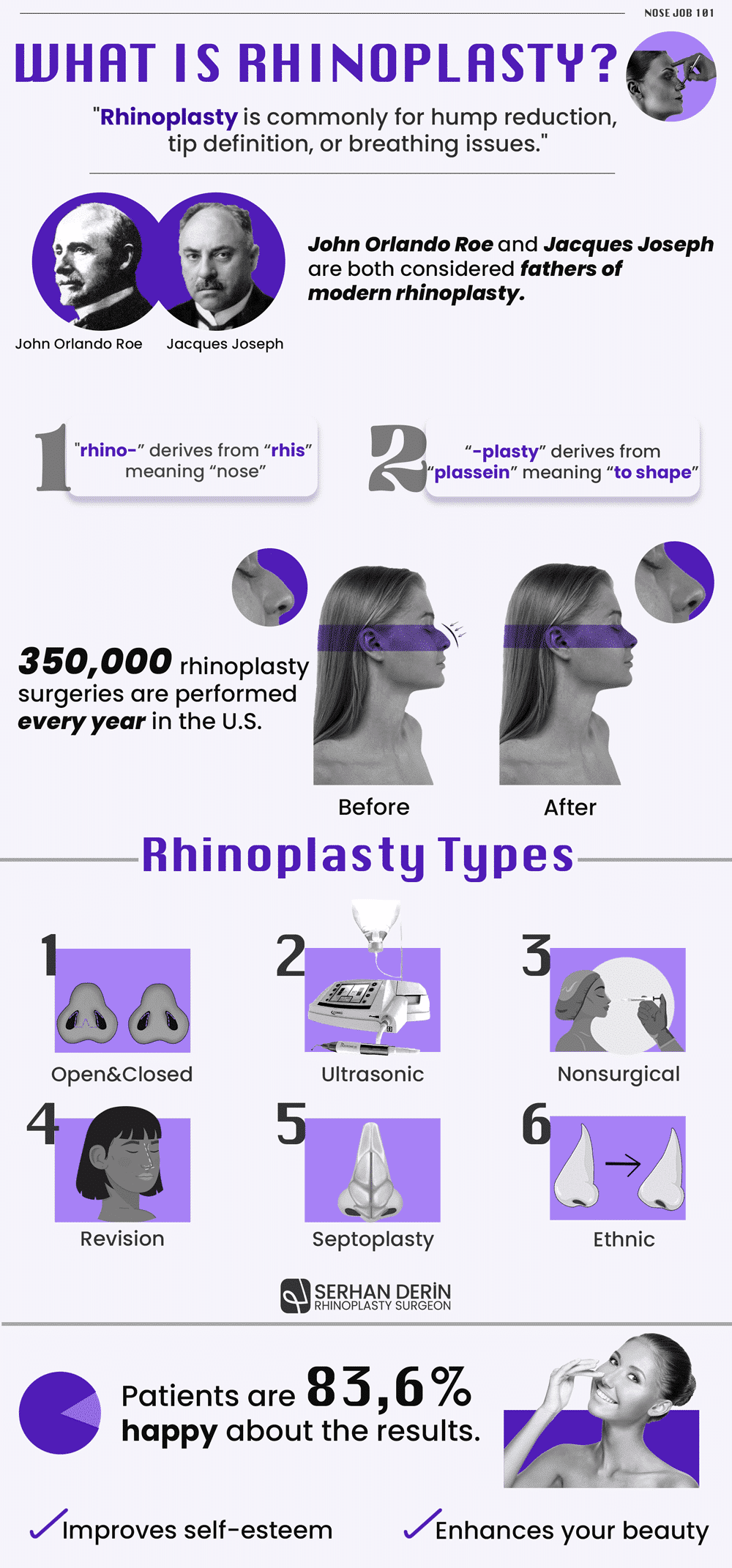
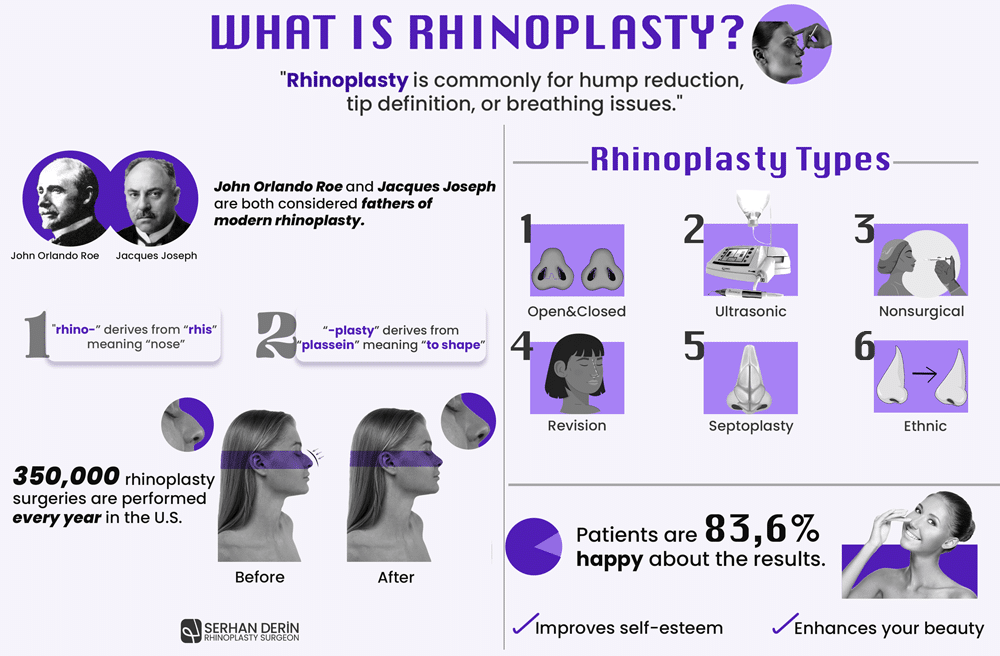
Today what we know as modern rhinoplasty was first developed by two important names John Orlando Roe and Jacques Joseph. They both made huge contributions to the academic world. Even there is a competition between them as to which one should be called the “Father of Modern Rhinoplasty” (1). Academic debates aside they were both successful rhinoplasty surgeons, and today we are still using some methods they developed.
Nowadays, rhinoplasty is among the most demanded plastic surgeries. Despite the fact that it’s challenging, thanks to huge demand and developing techniques, it is now widely performed all around the world. People look for rhinoplasty for cosmetic and functional reasons. Most of the time people get a rhinoplasty to reduce a hump, define the tip of the nose, or correct a breathing issue.
Every year in the U.S. there are 350,000 rhinoplasty surgeries performed. Down below you can also see the percentage of rhinoplasty surgeries among all the other plastic surgeries performed in the U.S.
- 15,2 in 2020
- 13,5 in 2019
- 11,7 in 2018
- 12,7 in 2017
There is a lack of comprehensive data regarding the annual number of rhinoplasty surgeries performed in each country. However, according to ISAPS 2021 report, a worldwide survey participating 14 countries with 995,149 nose surgeries, Brazil has the highest numbers with 7,9% followed by the U.S with 7,6% (2).
You may be curious about the reasons behind the popularity of nose surgery. Rhinoplasty has become increasingly popular due to advancements in techniques and increased accessibility. The use of modern technology has made it easier and more affordable for many people to undergo nose surgeries.
Another issue that people wonder about rhinoplasty is the terminology. Where did the term rhinoplasty come from?
Why is a nose job called rhinoplasty?
Although most people call it a “nose job” the formal and medical term for nose surgery is rhinoplasty. It sounds like the rhinoceros the animal, right? If you ever thought the same you are right, “rhinoplasty” and “rhinoceros” come from the same root and the similarity is surprising. So, why is it called rhinoplasty? When we take a look at the root of the word the term rhinoplasty comes from the ancient Greek language:
- “rhino-” derives from “rhis” meaning “nose”
- “-plasty” derives from “plassein” meaning “to shape”
Basically, when we combine these two, rhinoplasty means “reshaping the nose” (3).
The role of rhinoplasty: what can rhinoplasty achieve?
Rhinoplasty can rearrange your nose structure to make it look and function better. You might have one or more than one of these conditions and rhinoplasty can correct it:
- Symmetrical concerns: crooked bridge or up-down rotated tip of the nose
- Proportional concerns: wide, large, or small nose
- Functional concerns: deviated, collapsed, blocked, or injured nose
Basically, rhinoplasty can help you achieve a better-looking and functioning nose. It can make your nose smaller, bigger, or well-contoured on different parts while ensuring proper breathing.
So far, we checked “what is rhinoplasty” in general and explained it in simple terms. Now, let’s see the different types of rhinoplasty surgeries.
How many rhinoplasty techniques exist?
Rhinoplasty is a tree term for many different sub-branches or types of rhinoplasty. Their goals are mainly the same; achieving natural-looking results without compromising nose structure.
- Open and closed rhinoplasty
- Ultrasonic rhinoplasty
- Non-surgical rhinoplasty
- Ethnic rhinoplasty
- Revision rhinoplasty
- Septorhinoplasty
People also often confuse rhinoplasty and septoplasty. Rhinoplasty is not limited to but is generally concerned with the nose structure externally, while septoplasty is only performed to correct the internal separator wall (nasal septum).
This situation is called a deviated septum. It is different than a crooked nose which is corrected by a rhinoplasty operation. When your nose is crooked you can easily tell but the septal deviation is not always visible. You can learn more about this issue in our rhinoplasty vs septoplasty article.
Let’s talk process: a journey through the OR
The surgery involves lots of different stages and there are some considerations one should understand before getting the surgery. In basic terms, rhinoplasty has three different stages:
- Before the operation: This is the beginning of a rhinoplasty journey in which patients convey all their concerns and get ready for the operation.
- During the operation: In surgery, surgeons use delicate incisions and surgical techniques to shape your nose in the intended way.
- After the operation: Right after the surgery you will have a week of rest, and to see the full results you will have to wait for a while.
For further details, you should keep reading to understand what is done in each procedure and to see what you should consider.
Before the operation
Before the surgery, you will have a consultation process, in which you will talk about your expectations and understand the surgical procedures. When you are settled with the operation, your doctor will also inform you about the preparation process. You might be asked to stop using some medicines and change your diet with a few daily habits, especially the day before the surgery.
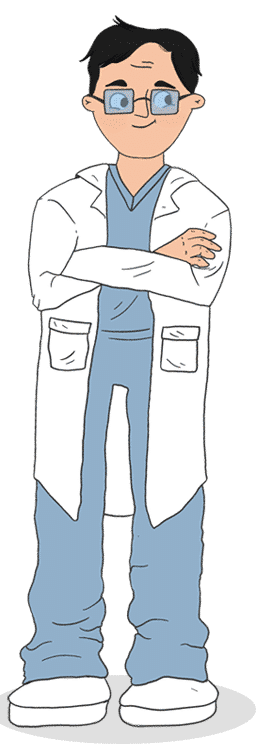
Consultation

This is the beginning of your rhinoplasty surgery journey. You should talk about what you need to change on your nose and let your doctor know all your concerns about your nose.
During the consultation, you will be able to explain your concerns and go over the changes desired for your nose. The surgeon makes a physical exam on your nose and assesses its shape, skin type, and conformity to your desired outcome. To help visualize the potential of surgery, 3D computer imaging can be utilized.
While it is a chance to get to know your doctor, the same can be said for your doctor too. Make your research before this session since an experienced surgeon is a must for success. Try to understand why the surgery is complicated. Not everything you asked might be possible. Your surgeon will explain what improvements can be made.
Preparation
After a consultation process, when you planned everything about your surgery, now it’s time to get ready for the surgery. Your surgeon might ask you to stop taking some medicines, give a break from tobacco products and follow a healthy diet for a while. Some of these precautions are vital to have a seamless surgery and a complication-free recovery period.
Some tests before your rhinoplasty surgery might include:
- X-ray or tomography of your chest and nose
- Blood tests for HIV, Hepatitis, and kidneys
- ECG
Besides if you have chronic problems, such as diabetes or cardiovascular diseases you should consult your doctor before taking the surgery.
During the operation
During the surgery day, you will be there with an empty stomach. In the operating room, the first and last thing you will remember is anesthesia. After you are asleep they will make the starting incisions to access the inner side of your nose.
Inside your nose surgeons manipulate the cartilage and nasal bones with; grafting, suturing, and sculpting techniques. All the changes that will highlight the beauty of your nose are performed in this stage. Right after finishing everything surgeons make closure sutures and it is done.
The choice of anesthesia
The first stage of the surgery is the only part that you will remember from the operation room, anesthesia. Either general anesthesia or local anesthesia is applied before making incisions on your nose so you will not feel anything. The choice of anesthesia depends on the surgeon’s preference and rarely it is asked of you.
Starting incisions
After anesthesia kicks in, surgeons make the starting incisions open and closed techniques. Most surgeons prefer an open technique in which your nose is wide open and easy to operate on. The closed approach on the other hand requires much more expertise since all the operation is done through narrow nostrils.
From a patient perspective, the main difference between them is the visible scarring after an open approach compared to a closed one.
Operation techniques used inside and around the nose
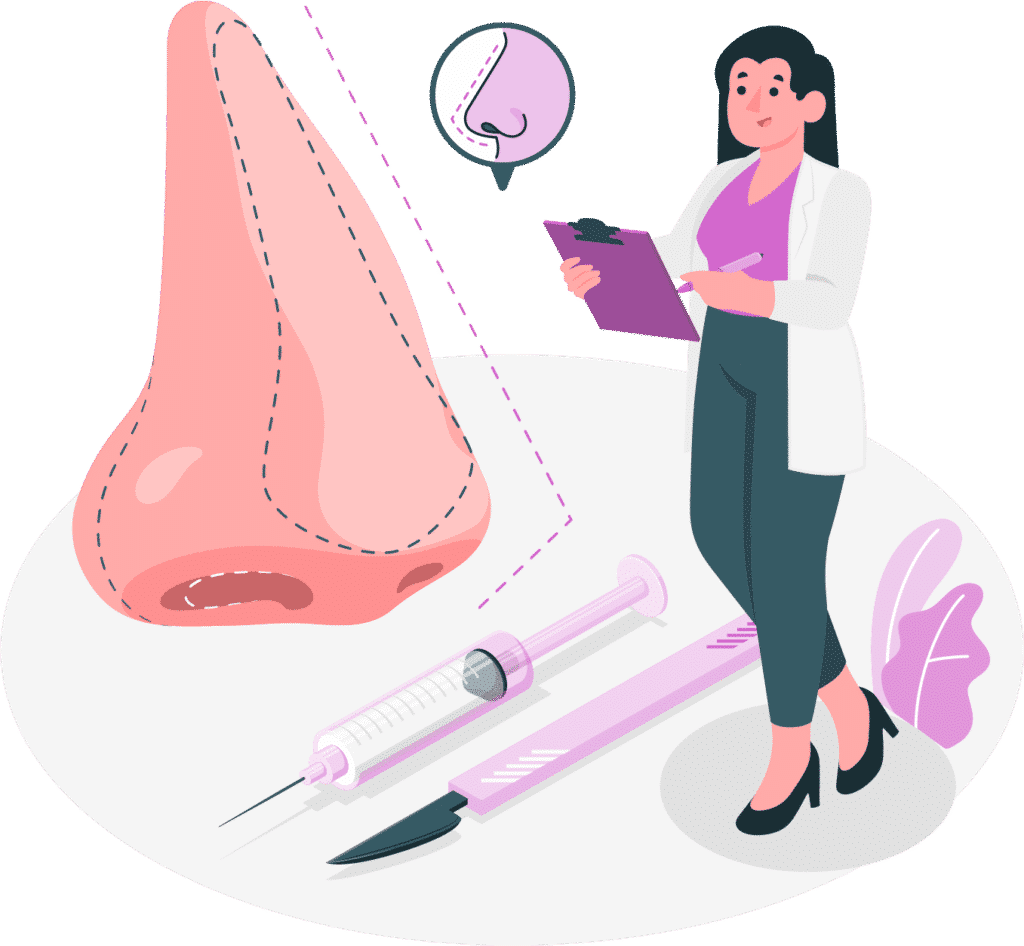
Once the incisions have been made, the surgeon carefully lifts the skin and soft tissue to access the underlying bone and cartilage. They may use specialized instruments to trim, remove, or rearrange the bone and cartilage to create the desired shape and size of the nose.
The specifics of the reshaping will depend on the individual patient’s needs and the surgeon’s technique. For example, if the patient has a bump on the bridge of the nose that they would like removed, the surgeon will carefully shave down the excess bone until the bridge is smooth and even.
For patients with noses that are either unusually wide or pinched slim, a surgeon could work their magic by adding or removing cartilage to bring it to the perfect width.
Closure
Once the reshaping is complete, the surgeon carefully repositions the skin and soft tissue back over the nose and closes the incisions using sutures. After the procedure is complete, there may be a few stitches or splints placed on your nose.
After the operation
You will need at least a week of rest after the surgery as it is an invasive surgery. The moment you wake up from the operation, you might feel a little dizzy. Since it is generally an outpatient surgery, you might need someone to be here at this time to drive you home.
Swelling, bruising, and bleeding can be seen within the first week and they will all subside and heal nicely. You might use a drip pad, and sleeping on your side with an elevated head should also help. During the first 5-6 weeks after surgery, you should avoid strenuous activities such as exercising or running.
For more information about the recovery process, you should visit our article.
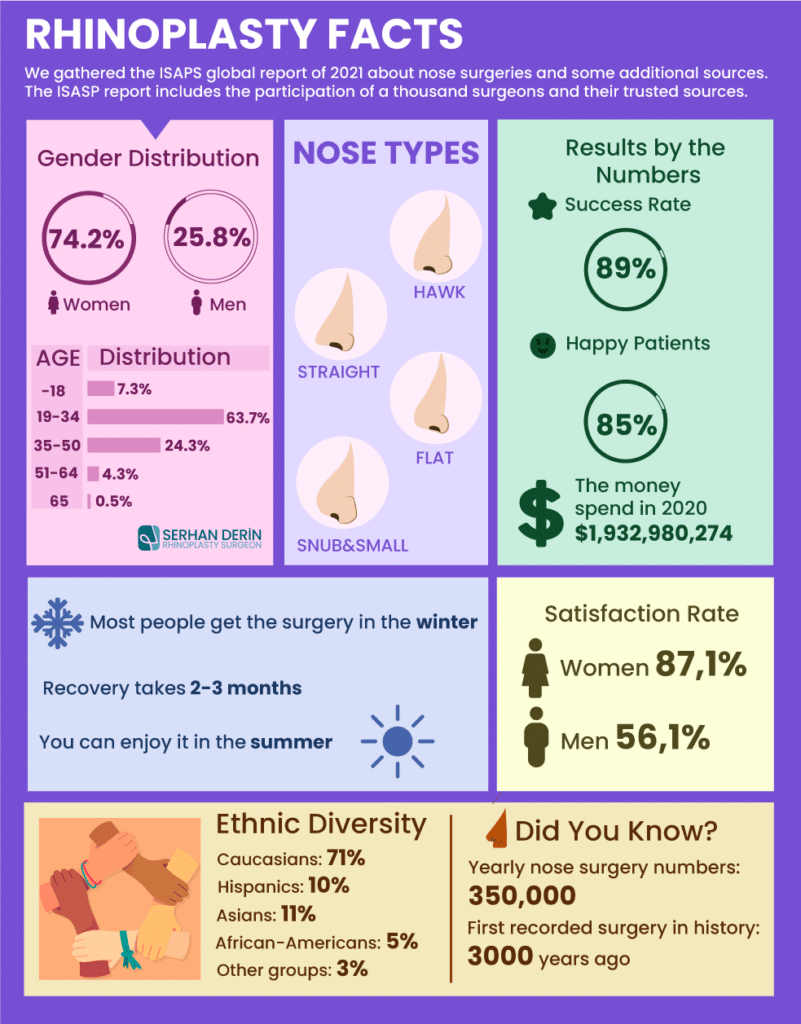
To nose job or not to nose job: pros and cons
It is common to hear various opinions on rhinoplasty, ranging from positive experiences of friends and family to negative personal stories from celebrities. Viewpoints can range, so it is important to have a comprehensive understanding before making an informed decision.
Here in this table, you can see all the pros and cons of rhinoplasty:
| Nose job benefits | Nose job downsides |
| Enhances your beauty | Anesthesia risks |
| Improves self-esteem | Subtle results |
| Corrects nose deformities | Scarring, infection, and numbness |
| Gives you a fresh breath | Possible revisions |
Now, we will dive into the details of each one of these.
The positive impacts of rhinoplasty
One of the most important positive impacts of rhinoplasty is that it can enhance your beauty. It gives you a chance to change your appearance for good. Inevitably, the surgery will also affect your social life. You will no longer have to worry about which profile to take your pictures from, thus improving your self-esteem.
A rhinoplasty surgery is generally performed to enhance your beauty, but it is not limited to that. As it can correct any nasal structure issues like birth defects, it can also increase your nasal functions giving you fresh breath for a life-long. Often people are afraid of rhinoplasty because of pain and complications that they might live after the surgery.
So, is it painful?
No, rhinoplasty is not a painful process. You will feel nothing during the surgery and after that, within the first week you might have a little discomfort and that is all.
There is an overall patient satisfaction survey made with 2036 patients around a review website, rhinoplasty patients are 83,6% happy about the results of their surgery (4). So, based on these data, your surgery will be most likely successful and you will be satisfied.
Although the surgery is generally considered safe and has a high success rate, it is good to be informed about the downsides as well.
The downsides you need to know about rhinoplasty
It is not that common to have complications according to medical resources. Generally, the revision rate after primary surgery is around 7-15%. This means you will have something to think about here, but botched results are not that common.
The least common risk here is anesthesia risks which should not occur unless you follow the given instructions correctly. There are preparation and recovery stages before and after the surgery in which you should follow some rules like stopping smoking and drinking alcohol for a while to prevent this complication.
There is another important downside of rhinoplasty.
It cannot be perfect and often subtle. No surgeon offers you to have a perfect nose but a balanced one with every other element in your face. That is another reason to have realistic expectations before the surgery to not be disappointed.
Little surgical scars can be seen right after the surgery that is nicely healed during the first week. Persistent scarring, numbness, temporary loss of sense of smell, or infection can be seen after the surgery. These complications can be easily avoided. For infection, oftentimes surgeons opt for antibiotics for instance.
In some cases, if your previous rhinoplasty operation did not go well, secondary rhinoplasty might be required. This is seen when you have complications or do not like the results of your first surgery. The reason why people look for further surgeries is generally recovery complications. Also, a very good rhinoplasty surgeon will always be honest with you.
You may want to read our articles on things to know about a rhinoplasty nobody tells you.
The characteristics of a successful rhinoplasty candidate
The surgery is not limited to any nose type. Anyone who is looking for a change or improvement on their nose can get a rhinoplasty operation. Although, there are some qualifications seen in a good rhinoplasty patient. Rhinoplasty candidates are divided into three aspects; expectations of the patient, facial features, and health factors.
Your expectations should match with surgeon’s goals
Rhinoplasty surgery does not work like a mass industrial factory and the results will be unique for each individual. The reason behind this is your genetics and your specific nose shape. Surgeons always consider the most appropriate nose surgery for your needs while planning, but the thing is some people ask for more.
You should expect to see appliable changes, not everything you want. This is why you should have realistic expectations for better satisfaction and successful rhinoplasty results. Setting a realistic goal in your mind is important in that case.
Facial features
The surgeon takes into account the overall balance of your face while offering the most appropriate nose shape for you. Physical characteristics such as the prominence of your chin, the position of your eyes, and the existing features of your nose are all important considerations during a rhinoplasty procedure.
While most people opt for rhinoplasty for cosmetic reasons, it is also important to consider the nose’s functional aspects, such as breathing, smelling, and filtering. Surgeons strive to achieve a balance between aesthetic and functional outcomes in every rhinoplasty surgery.
Thick skin texture can pose a challenge during the surgery, as changes to the outer appearance may be harder to achieve. Surgeons also evaluate the deviation and position of your nose from different profile views, as a crooked or recessed nose can make the surgery more complex (5).
Health factors
To have a flawless surgical process, another factor that you need is your health. If you have ongoing illnesses such as diabetes, cancer, or similar conditions and have not received clearance from your doctor, it is not recommended to have cosmetic nose surgery.
In addition to these, being mentally prepared and not making the decision for the surgery on a sudden whim will be beneficial for you to have a healthy process. Making this decision only for your own happiness will be the healthiest option.
Additionally, your habits can also have a negative impact on the healing process. The most common negative factors include smoking and alcohol consumption. If you are not concerned about refraining from these for a while, it means you are a great candidate for rhinoplasty.
References:
(1) Rogers BO. John Orlando Roe–not Jacques Joseph–the father of aesthetic rhinoplasty. Aesthetic Plast Surg. 1986;10(2):63-88. doi:10.1007/BF01575272 Link
(2) International Society of Aesthetic Plastic Surgery 2021 Global Survey Report Link
(3) Macionis V. History of plastic surgery: Art, philosophy, and rhinoplasty. J Plast Reconstr Aesthet Surg. 2018;71(7):1086-1092. doi:10.1016/j.bjps.2018.03.001 Link
(4) Khansa I, Khansa L, Pearson GD. Patient Satisfaction After Rhinoplasty: A Social Media Analysis. Aesthet Surg J. 2016;36(1): NP1-NP5. doi:10.1093/asj/sjv095 Link
(5) Fanous N, Brousseau VJ, Karsan N, Fanous A. Predicting the results of rhinoplasty before surgery: Easy noses versus difficult noses. Can J Plast Surg. 2008;16(2):69-75. doi:10.1177/229255030801600209 Link

